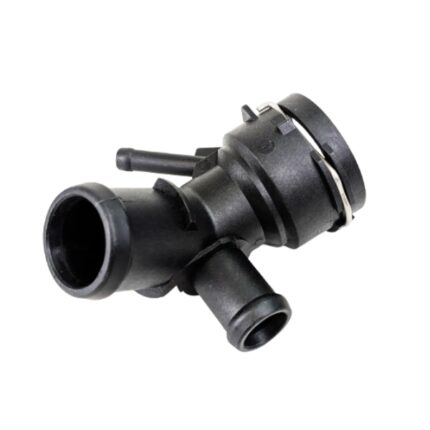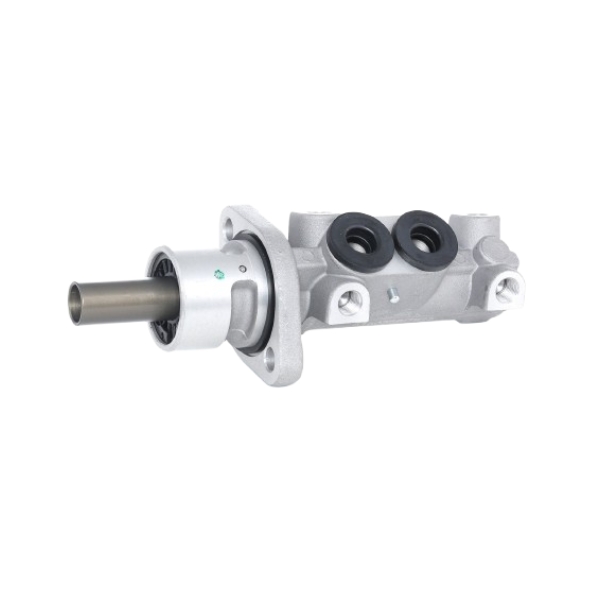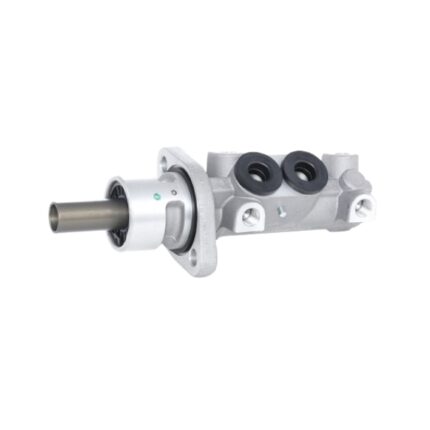-8%
Get VW Cabrio III Brake Master Cylinder 357611019B in Kenya
The brake master cylinder is one of the most crucial components in a vehicle’s braking system. It plays a central role in converting the mechanical force from the brake pedal into hydraulic pressure, which is used to engage the brakes at each wheel. Without a properly functioning brake master cylinder, a vehicle’s braking system would not operate effectively, compromising safety and vehicle control.
In this detailed guide, we will explore the function of the brake master cylinder, its importance, common issues, and how to maintain it for optimal braking performance.
What is a Brake Master Cylinder?
The brake master cylinder is a hydraulic device that generates pressure in the braking system when the driver presses the brake pedal. It is connected to the brake pedal via a pushrod and to the brake lines via hydraulic connections. In modern vehicles, the master cylinder is usually part of a tandem system, which means it operates two separate hydraulic circuits—one for the front brakes and one for the rear. This is a safety feature that ensures braking power is retained even if one of the circuits fails.
Function of the Brake Master Cylinder
- Converting Mechanical Force to Hydraulic Pressure: When the driver presses the brake pedal, a mechanical force is applied to the pushrod attached to the brake master cylinder. This force compresses the fluid inside the cylinder, converting it into hydraulic pressure. The pressurized fluid is then transmitted through brake lines to the brake calipers or wheel cylinders.
- Controlling Brake Force Distribution: In vehicles with a tandem master cylinder, the device controls two separate circuits: one for the front wheels and one for the rear. This ensures that the brake force is evenly distributed across the vehicle, which is essential for balanced and efficient braking.
- Maintaining Hydraulic Pressure: The master cylinder contains a set of seals and pistons that keep the hydraulic fluid pressurized and prevent air from entering the system. This pressurized fluid is what ultimately activates the brakes when the driver presses the pedal.
- Safety Backup: The design of modern master cylinders often includes two chambers, allowing for a dual-circuit system. If one hydraulic circuit fails (due to a leak or other issue), the second circuit can still provide braking power to either the front or rear brakes, allowing the driver to stop the vehicle safely.
Types of Brake Master Cylinders
There are several types of brake master cylinders based on the braking system design:
- Single-Circuit Master Cylinder: Older vehicles typically used a single-circuit master cylinder. In this design, one hydraulic circuit serves all four brakes. If there is a leak or failure in this single circuit, the entire braking system fails, which is why single-circuit systems are no longer used in modern vehicles.
- Tandem or Dual-Circuit Master Cylinder: Most modern vehicles use a tandem or dual-circuit master cylinder. This design features two separate hydraulic circuits, usually one for the front wheels and one for the rear. The dual-circuit system improves safety by ensuring that one set of brakes will still work if the other fails.
- ABS-Integrated Master Cylinder: In vehicles with an Anti-lock Braking System (ABS), the brake master cylinder is often integrated with the ABS unit. This allows for precise control of brake force under heavy braking, reducing the risk of wheel lockup and improving vehicle control in emergency situations.
Components of a Brake Master Cylinder
- Reservoir: The reservoir is a small tank attached to the master cylinder that holds the brake fluid. It ensures there is always an adequate supply of fluid to keep the hydraulic system pressurized.
- Piston(s): Inside the master cylinder, one or more pistons move forward when the brake pedal is pressed. These pistons are responsible for compressing the brake fluid and generating hydraulic pressure.
- Seals and O-rings: The seals inside the master cylinder prevent fluid from leaking past the pistons. These seals are essential for maintaining pressure in the hydraulic system.
- Pushrod: The pushrod connects the brake pedal to the master cylinder. When the driver presses the brake pedal, the pushrod pushes the piston(s) inside the master cylinder, generating pressure in the brake lines.
- Brake Fluid Ports: There are ports inside the master cylinder that allow brake fluid to flow into the piston chamber when the pedal is released. This ensures that the master cylinder remains filled with fluid and ready for the next braking event.
Importance of the Brake Master Cylinder
- Safety-Critical Component: The brake master cylinder is the central element in a vehicle’s hydraulic braking system. Without it, the brakes would not engage, making it impossible to stop the vehicle effectively. This is why it’s a safety-critical component, and any issues with the master cylinder should be addressed immediately.
- Enables Consistent Braking: A properly functioning master cylinder ensures that brake pressure is consistent every time the driver presses the brake pedal. Inconsistent or weak pressure can lead to longer stopping distances or complete brake failure, both of which are dangerous.
- Maintains Hydraulic Pressure: The master cylinder maintains the hydraulic pressure necessary to operate the brake calipers or wheel cylinders. It is designed to contain brake fluid and generate sufficient pressure for efficient braking.
- Redundancy in Case of Circuit Failure: The dual-circuit design of most modern master cylinders provides an extra layer of safety. Even if one circuit fails, the other can still operate, allowing the vehicle to be stopped safely.
Common Issues with Brake Master Cylinders
Despite being a robust component, the brake master cylinder can develop problems over time due to wear and tear, contamination, or aging. Some common issues include:
- Internal Leaks: Over time, the seals inside the master cylinder can wear out, allowing brake fluid to bypass the piston. This reduces the hydraulic pressure and can lead to a soft or spongy brake pedal.
- External Leaks: Brake fluid may leak from the master cylinder’s external connections, such as where it attaches to the brake lines or the pushrod. This can result in a loss of brake fluid, leading to reduced braking performance or complete brake failure.
- Brake Pedal Fade: A master cylinder with worn seals can lead to brake pedal fade, where the pedal sinks to the floor without effectively engaging the brakes. This is a serious issue and should be addressed immediately to prevent accidents.
- Contaminated Brake Fluid: If the brake fluid becomes contaminated with moisture, dirt, or debris, it can affect the master cylinder’s ability to maintain pressure. Contaminated fluid can also corrode the cylinder’s internal components, leading to failure.
- Hard Brake Pedal: If the master cylinder’s internal components are damaged or corroded, it may cause the brake pedal to become unusually hard, making it difficult to apply the brakes.
Signs of a Failing Brake Master Cylinder
- Soft or Spongy Brake Pedal: One of the most common signs of a failing master cylinder is a soft or spongy brake pedal. If the pedal feels mushy when pressed, it may indicate internal leaks or air in the brake lines.
- Brake Pedal Slowly Sinks: If the brake pedal sinks slowly to the floor when pressed, it’s a sign that the master cylinder is not maintaining pressure, likely due to worn seals or a fluid leak.
- Reduced Braking Power: If it takes more effort to stop the vehicle or the stopping distance has increased, the master cylinder may be failing to generate sufficient hydraulic pressure.
- Brake Fluid Leaks: Visible brake fluid leaks around the master cylinder or under the vehicle can indicate a failing master cylinder. Leaks should be addressed immediately, as low brake fluid levels can lead to brake failure.
Maintenance and Replacement of the Brake Master Cylinder
Proper maintenance of the brake master cylinder is essential for safe and efficient braking. Here are some key maintenance tips:
- Check Brake Fluid Levels Regularly: Ensure that the brake fluid reservoir is always filled to the proper level. Low fluid levels can cause air to enter the hydraulic system, leading to reduced braking performance.
- Inspect for Leaks: Regularly check around the master cylinder and brake lines for signs of leaks. If any leaks are detected, the affected components should be repaired or replaced immediately.
- Brake Fluid Flush: Brake fluid should be flushed and replaced every 2-3 years or according to the vehicle manufacturer’s recommendations. This prevents contamination and ensures that the hydraulic system remains in good condition.
- Replace Worn Components: If the master cylinder seals or internal components become worn or damaged, they should be replaced promptly to prevent brake failure. In some cases, the entire master cylinder may need to be replaced.
- Bleed the Brakes: If air enters the hydraulic system, the brakes will feel soft or spongy. Bleeding the brakes removes trapped air and restores proper hydraulic pressure.
Conclusion
The brake master cylinder is an essential component of a vehicle’s braking system, converting mechanical force from the brake pedal into hydraulic pressure that engages the brakes. It plays a vital role in maintaining braking power and ensuring safe, efficient vehicle operation. Proper maintenance, such as checking brake fluid levels, inspecting for leaks, and flushing the brake fluid regularly, can extend the life of the master cylinder and prevent common issues like internal leaks or brake pedal fade. Understanding the function and importance of the brake master cylinder helps ensure that drivers remain safe on the road, with a fully operational braking system that can be relied upon in any situation.
Follow us on Facebook for more parts.





Reviews
Clear filtersThere are no reviews yet.